What is plasma fibroblast therapy?
Plasma fibroblast treatment is a nonsurgical skin-tightening procedure that uses a high energy discharge to make a small wound in the skin. This can encourage cells known as fibroblasts to repair the skin and maintain firmness.
Nonsurgical skin tightening is a relatively common procedure. This less invasive treatment has a shorter recovery period than surgical options, but its results are not as dramatic and do not last as long.
Plasma fibroblast therapy is a newer technique, and therefore, there is currently little evidence to support its effectiveness.
In this article, we discuss what plasma fibroblast therapy is, as well as whether it’s effective and safe.
Plasma fibroblast therapy is a cosmetic treatment that may help tighten the skin. Its other names are:
- plasma skin resurfacing
- plasma skin regeneration
- plasma needling
- plasma lift
This treatment aims to improve the skin’s appearance by using plasma, which is a hot, gas-like substance, to stimulate the fibroblast cellsTrusted Source in the deeper layer of the skin to repair the outer skin layers. Some institutions describe plasma as the fourth state of matter, along with solid, liquid, and gas.
A fibroblast is a type of skin cell that secretes collagen proteins in the dermis, the layer of the skin just below the outermost skin layer. These cells play an important roleTrusted Source in wound healing and maintaining skin firmness and tightness.
A trained professional uses a pen-like device that discharges plasma for the treatment. By applying energy to a gas, it creates a cloud of charged ions that is extremely hot and emits electromagnetic radiation.
Using the device, a person can release a targeted, hot electric current to the skin to create a small hole, or microinjury, in the skin. In response to the microinjury, fibroblasts activate and attempt to repair and regenerate the skin.
the heat a plasma pen generates may:
- stimulate fibroblast activity
- encourage tissue regeneration
- break down proteins in the skin
- result in tissue tightening
Evidence suggests that plasma fibroblast therapy can tighten the skin in a number of areas, including the:
- face
- neck
- arms
- breasts
- stomach
- buttocks
- thighs
- knees
How long does plasma fibroblast last?
Results from plasma fibroblasting treatments typically last about three years, but this varies depending on the patient.
Once new collagen forms, it has been shown to stick around for upwards of 15 years. But since the aging process never stops, existing collagen is constantly being broken down.
A treatment plan that includes annual follow-ups can help prolong results. Wearing a sunscreen with an SPF of 50+ will also help preserve collagen and prevent new wrinkles
AFTERCARE DO’s
Be patient, the healing part is a process. Take time to rest, sleep and heal.
Oedema (swelling) may also occur. Sleeping on 2 pillows with your head elevated helps.
Ice the treated area for at least 10 minutes every hour. Don’t use ice directly on skin, use a clean towel covering the ice pack.
Apply a fine layer of your advised aftercare cream to treated areas several times a day if needed to maintain continuous layer on skin for the first 2 days. Be sure to thoroughly wash your hands prior to touching your face.
CLEANING THE SKIN: Until the scabs come off, you may on directions of your doctor soak the treated area with a clean soft cloth and the following solution: 1 teaspoon of plain white vinegar to 2 cups of water. This solution may be mixed ahead of time and kept in the fridge.
Do not apply ANY other creams, ointments or products of any kind on face until you are told it is ok to do so.
Do not pick the scabs off. Let them come off on their own. You will increase risk of infection and scarring if you pick the scabs. Let them exfoliate on their own,
Do not expose your skin to the sun or tanning beds. remember UVA light passes through house and car windows. Use of sunscreen with SPF 50 is crucial to maintain results and help prevent post inflammatory pigmentation (darker areas)
It is ok to shower but do not let the shampoo or hair products get on your face.
Panadol may be used if needed
If you experience itching, an over the counter antihistamine may be helpful.

